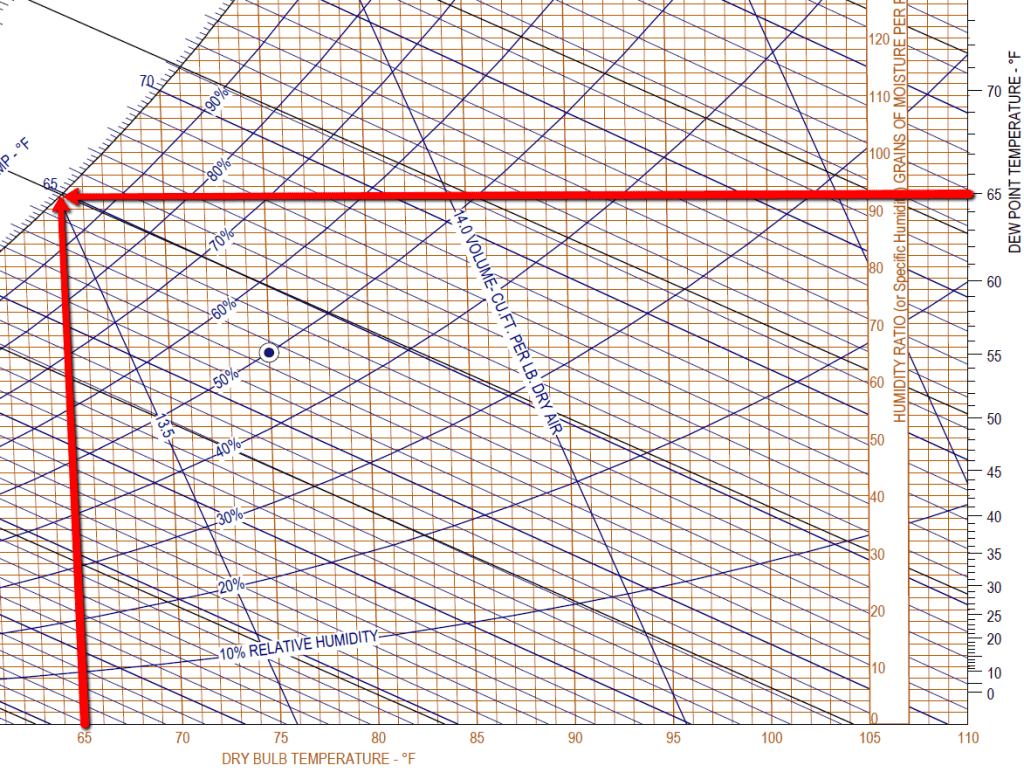Get Tech Tips
Subscribe to free tech tips.
Understand Dew Point and Absolute Moisture, The Right Side of the Psych Chart

Let's first state the obvious. Most techs are intimidated by psychrometric charts and Mollier diagrams. We JUST ARE. While there are some pretty complicated formulas that back up these diagrams, using them isn't that big of a deal once you understand the different elements and then focus on one at a time.
BUT WHY DO YOU CARE?
Dew point is one example of a very useful measurement to understand, design for, and test for in an HVAC/R system. Take an evaporator coil; do you know how to calculate the exact temperature at which that evaporator coil will start to condense moisture? Can you tell the exact temperature at which a surface inside of a space will start to condensate and possibly grow mold? These are both cases where a basic understanding of a psychrometric diagram can help a technician.
While some of the elements on the chart are represented by curved or slanted lines, dew point temperature and humidity ratio/absolute moisture content values are just straight lines horizontally across the chart.

So, if we focus on a 65°F (18.33°C) dew point on the right side of the chart, you will notice that it crosses over 92 grains (there are 7000 grains of moisture per lb) of moisture line and then goes all the way across until it intersects with the curved 100% humidity line on the left side. That shows us that at a 65°F (18.33°C) dew point, the air always contains 92 grains of moisture per lb. ALWAYS.
It also shows us that when the air is at 100% relative humidity, the dew point, wet bulb, and dry bulb temperatures are ALL THE SAME.

If we have a dew point of 55°F (12.77°C), the air contains 64 grains of moisture per lb. If the dew point is 30°F (-1.11°C), the air contains 24 grains… you get the point.
So, if you find the dry bulb temperature and the relative humidity now, you can easily calculate the dew point at which that same air will reach saturation and begin to form condensation.
Let's say we have 75°F (23.88°C) dry bulb air at 50% relative humidity. We would simply draw a line up from the bottom at 75°F (23.88°C) until we hit the curved 50% line. Then, go right (or left) until you bump into the grains of moisture and then the dew point scale. Now you know at what temperature that same air mass will start to condense water.
So. we can see that if this 75°F (23.88°C) dry bulb and 50% relative humidity mass of air comes in contact with a surface that is 55.5°F (13.05°C) or less, it will begin to condense water. We also know that this airstream contains 65 grains of moisture per lb of air.
Forgive me for saying so, but I think this is pretty cool.
—Bryan
P.S. – If you want a good quality Psychrometric chart, you can use THIS ONE.











Comments
Skip Krepcik did an excellent presentation at the 2017 HVAC Excellence Educators Conference. He showed that using the psychrometric chart you can determine if a roof top unit is properly sized when it is equipped with an economizer.
Skip Krepcik did an excellent presentation at the 2017 HVAC Excellence Educators Conference. He showed that using the psychrometric chart you can determine if a roof top unit is properly sized when it is equipped with an economizer.
Nice chart, I was looking for a nicer chart than I have for teaching my classes.
Nice chart, I was looking for a nicer chart than I have for teaching my classes.
I’m glad this helped you. Thanks for your feedback.
I’m glad this helped you. Thanks for your feedback.
This is my first Tech Tip and I had a lot of fun with it. I took two glasses of water outside, one at one degree below dew point and one at one degree above. And of course the one below fogged up and the one above stayed clear. My wife said I was a dork and walked back inside. Thanks for the great info!
This is my first Tech Tip and I had a lot of fun with it. I took two glasses of water outside, one at one degree below dew point and one at one degree above. And of course the one below fogged up and the one above stayed clear. My wife said I was a dork and walked back inside. Thanks for the great info!
Maybe you will be interested…
Psychrometric chart – the program allows performing calculation of the moist air treatment processes and plotting them on a psychrometric chart.
http://www.softhvac.com/psychrometric-chart
Maybe you will be interested…
Psychrometric chart – the program allows performing calculation of the moist air treatment processes and plotting them on a psychrometric chart.
http://www.softhvac.com/psychrometric-chart
To leave a comment, you need to log in.
Log In